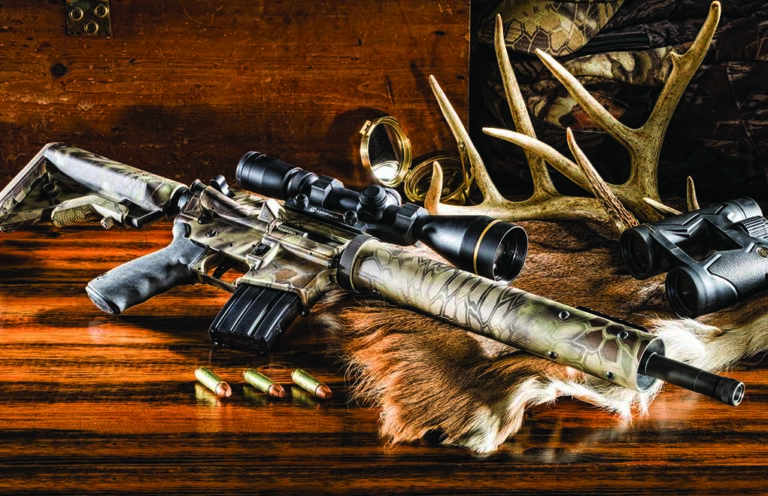
The big-bore AR continues to evolve, bringing heavier loads and practical options to the modern sporting rifle.
How Top Big Bore AR Options Mesure Up:
Ignoring for the moment that AR acronym stands for “Armalite Rifle” rather than “assault rifle,” the AR platform continues to evolve in functionality and efficiency, all the while fending off potential bans and misinformation. But let’s get down to the basics that have made Eugene Stoner’s design so long-lived.
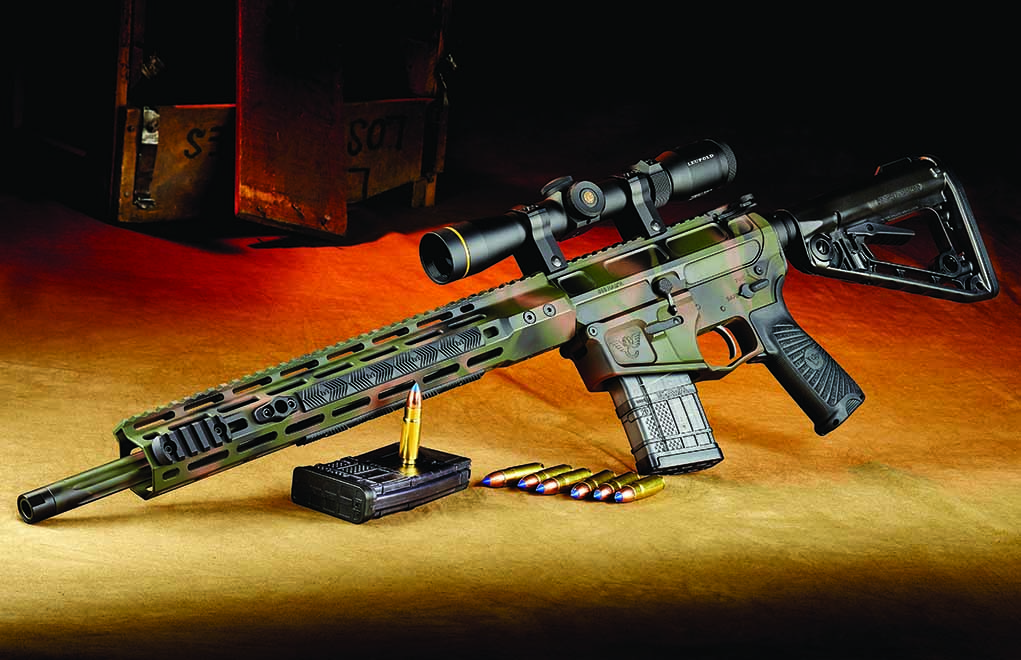
First, the ergonomics are universally appreciated. When viewed broadly over its 55-year lifespan, little has changed in terms of the pistol grip locations and angle, the trigger and safety location, the upper/lower concept, and the mechanism for loading and re-loading. The bolt carriage group (BCG) design remains largely the same, as does the direct impingement system that utilizes gas and a buffer spring to cycle the rifle’s action. Have there been improvements in handguards, stocks, charging handles, optics and triggers? Certainly. Still, the fundamental platform remains the same.
So what’s next? The military side of the house has bolted on and integrated optics, electronics and ergonomic improvements designed to improve reliability, range and accuracy in their issued calibers. With the ongoing war on terror pushing 20 years, we sadly have buckets of trial and error cycles to refine what works on the outside of the weapon system.
But what about the inside of the rifle and the civilian market? For hunters, target shooters and general enthusiasts, finding applications for the AR platform has taken a slightly different path. At times, such as the .300 Blackout/Whisper, the cross-over had its genesis in the military world — but in many cases, American civilian shooters began doing what they do best: tinkering with an existing idea and adapting it to new applications.
Bring On The Big Bores?
Ironically, the concept of a “big bore” in the modern sporting rifle vernacular has come to mean anything larger than the 5.56x45mm NATO round issued for the M-16/M4 platform since its introduction into military service in the 1960s. However, Stoner’s original design, the AR-10, was chambered for the 7.62x54mm (.308 Win.) cartridge. The issued rifle of the day was the M-14, and the prevailing military thinking was that a .30-caliber bullet was the optimal balance between weight, range, and knockdown power.
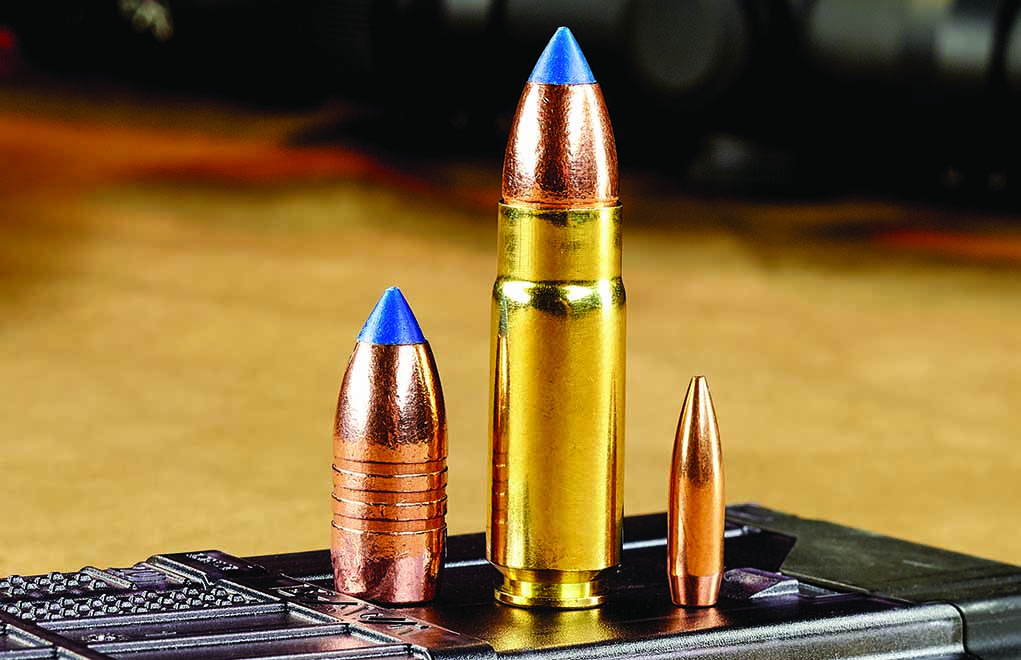
In a Cold War departure from the experiences of World War II and Korea, the decision was made to reduce the cartridge to the current 5.56x45mm. Nonetheless, Stoner’s internal design did provide several scalable advantages for larger calibers.
First, the buffer spring and gas direct impingement system considerably reduces felt recoil by utilizing a buffer tube and spring to absorb the kinetic energy displaced backward when a cartridge fires. Second, it also eliminates the need for an operating rod, which increased the weight and mass moving toward the shooter when a round cycled. AK fans will note this system diminishes reliability and makes for a dirtier action, and they’d be right. But until we’re shooting “freaking laser beams,” the laws of physics still apply, and you have to give to get.
More Info: Five Top Big-Bore ARs and Cartridges
So with the pluses and minuses acknowledged, let’s dig into the new stuff. Like rocket ships and dragsters, Americans aren’t historically burdened by practicality when it comes to pushing the engineering envelope of speed and power. ARs are no exception, and the direction within the civilian market has been to adapt the platform to larger calibers typically reserved for bolt or lever-action hunting rifles. We love our speed, but the sheer kinetic punch of a .40 caliber or larger rifle bullet seems to be in our DNA.
The Wilson Combat .458 Ham’r
Since 1977, Wilson Combat (WC) has been finding ways to make the old better or come up new twists on time-tested themes. Few, if any, 1911 aficionados don’t count their collection incomplete if there is not a WC square gun in it.
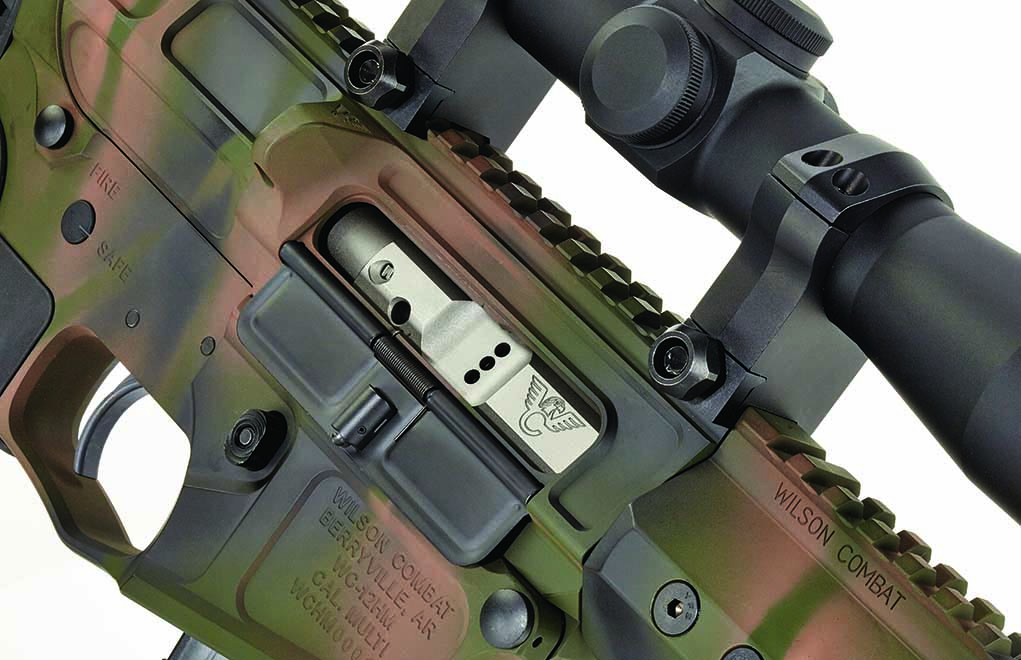
In 2016, both Bill Wilson and his grandson took a Cape buffalo on a trip to Africa with a .458 SOCOM. In both cases, and on smaller, “less-dangerous” game, it was also effective. Also, in some circumstances at longer ranges, the bullets didn’t fully expand, but the energy and size of the projectile closed the terminal ballistic game. Despite the relative success in the field, it sparked an idea in Bill’s mind that the .458 cartridge could use some help.
At a muzzle velocity of about 1,900 fps for a 300-grain round, the .458 SOCOM’s ballistics are similar to the classic .45-70 Gov’t. But like the .45-70, the trajectory graphs like a rainbow, making holdover a challenge at longer ranges. In other words, every little bit of speed helps.
The .458 Ham’r, with the same Barnes round, rips out at 2,100 fps and nearly 3,000 ft-lbs. of energy from the muzzle. This not only improves terminal performance, but it also mitigates the margin of error if the shooter is using open or red-dot sights and must visually estimate both distance and holdover.
Building the .458 Ham’r was not all about the cartridge, however. Wilson wanted to eliminate some of the reliability symptoms he had occasionally seen with the .458 SOCOM. Built on an AR-10 upper, the system can handle the increased chamber pressures of up to 46,000 psi, and Wilson shortened the bolt carriage group by ¾-inch to better handle the shorter cartridge. Other small tweaks, such as a larger ejection port to accommodate the wider case and a switch to a rifle primer for their WC’s proprietary ammo, further tightened the reliability and accuracy sweet spot.
Read More: The Big Shot — Wilson Combat’s .458 HAM’R
The lower for the .458 Ham’r is specific to the rifle’s unique design, so they only sell complete rifle packages, but WC does offer a .458 SOCOM upper for AR lowers.
The .450 Bushmaster
Many would rightly argue the .450 Bushmaster began the big-bore AR movement. Originally conceived by Tim LeGendre as an answer to Colonel Jeff Cooper’s disappointment in the 5.56x45mm (AR-15’s) terminal effectiveness on game, Cooper wanted a “thumper” that could be counted on to consistently put game on the ground inside 200 yards. After some experimentation and a joint experiment with Hornady Ammunition, Bushmaster launched the 250-grain SST Flex-Tipped .45-caliber cartridge in a straight-walled .284 Winchester case and dubbed it the .450 Bushmaster.
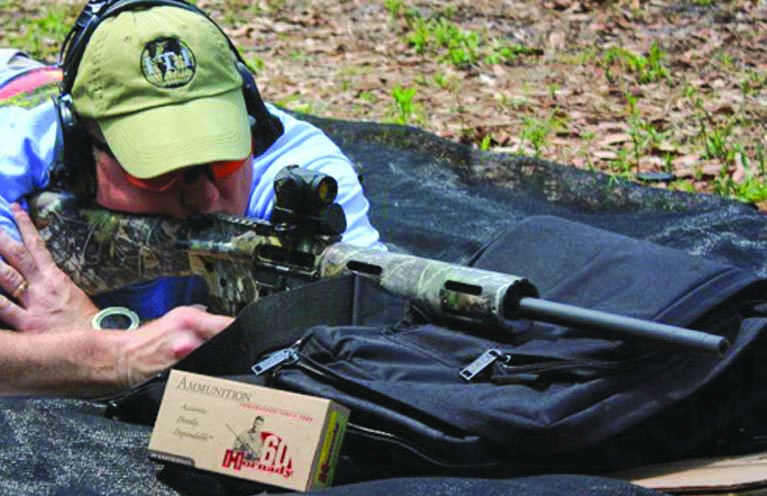
The advantage to this cartridge within the AR platform had several benefits. First, it lent itself to a single-stack, magazine-fed operation, exceeding that of most internally fed bolt-action rifles. Further, the muzzle velocity of 2,214 fps (in the 250-grain bullet) provided a relatively flat trajectory inside of 200 yards. Finally, the 2,700 ft-lbs. of energy delivered a significant terminal punch, along with the wide frontal profile (vs. a .30 caliber).
The round grew in popularity with the increase in the number of feral hogs nationwide and made for an excellent deer rifle. Most notably, the .450 Bushmaster uppers are compatible with most AR-15 lowers, which allows budget-minded shooters to simply purchase the upper, ammo and new magazines to create a dramatically different hunting platform vs. their 5.56x45mm/.223 Rem.
Bushmaster Arms produces the .450 Bushmaster AR in a 16- and 20-inch barrel models. For 2017, they rolled out a SOPMOD stock, ALG Defense nickel Teflon, mil-spec trigger, a square key drop modular hand guard and a slightly enlarged ejection port.
More AR Info:
- Should You Own A Pistol Caliber Carbine?
- Top Options In AR Pistols From Daniel Defense
- Properly Using A Defensive AR-15 From Cover
- Best AR-15 Suppressor Options For A Quiet Advantage
The Bushmaster .450 has also enjoyed increasing popularity due to regulation changes in some states where straight-wall-cased cartridges are allowed where hunters were previously limited to shotgun slugs-only (non-rifles). Be sure to confirm in both your state and region whether regulations allow for straight-walled rifle cartridges and, if so, the capacity limits. Game wardens tend to be universally intolerant of hunter’s pleading ignorance on this point.
The Alexander Arms .50 Beowulf
Taking the big-bore concept and making it slightly bigger, Bill Alexander of Alexander Arms introduced the .50 caliber Beowulf in 2001. Alexander has been out in front of several trends that continue to grow in popularity, such as the 6.5mm bullet which he chambered for the AR-15 platform in the 6.5 Grendel in 2001. In a nod to his British heritage, Beowulf and Grendel are characters (both heroic and evil) from one of the oldest surviving pieces of English literature.

Beowulf, a monster and dragon-slayer even into his old age and the subject of the ancient epic poem, is a fitting name for the cartridge that ranges in mass from 200 up to 400 grains. The muzzle velocity varies between 1,771 and 1,870 fps depending upon the load. Like the .450 Bushmaster, the .50 Beowulf upper can be purchased instead of a complete rifle and bolted to a mil-spec AR-15 lower.
The .50 Beowulf’s advantages, like the other big bores running in an AR platform, are best illustrated by a comparison with the standard issue 55-grain .223 Rem. bullet. The .50 Beowulf has four to seven times the bullet mass (depending on the load), three times the energy, and on average twice the frontal area.
Also See: Alexander Arms .50 Beowulf Hunter
Granted, it moves slower and has less range, but to broad-brush this comparison in football terms, imagine you’re a quarterback. Would you rather be sacked by a single safety … or a linebacker, defensive end and a nose guard all at once? The relative effect is similar on game with a 200-yard range: The .50 Beowulf delivers a blow that neutralizes most earthly mammal’s desire to do anything but go down and stay down. Alexander Arms has also recently released a 200-grain cartridge with an advertised muzzle velocity of 2,500 fps.
Innovation Or Hype?
Ultimately, a big bore AR is a personal choice. There are definitely longer range bolt-action rifles on the market and very solid AR offerings in the .260-.30 caliber range that cost more than your truck — and whose ballistics may, in some respects (particularly distance), outperform these big bores. But if your big game quarry is typically taken within 200 yards, these AR’s will save you the trouble of tracking if your shot is well placed — their terminal impact is simply devastating. Or, if you’re a range guy and like to make things explode when you shoot them, big bore ARs are definitely for you and a helluva lot of fun.

Finally, if you’re an average Joe with kids to feed who wants to have an interchangeable mil-spec AR and a heavier hunting option without breaking the bank, a big bore AR upper is often a solid, more-affordable option than a second gun.
Editor's Note: This article originally appeared in the October 2018 issue of Gun Digest the Magazine.

Next Step: Get your FREE Printable Target Pack
Enhance your shooting precision with our 62 MOA Targets, perfect for rifles and handguns. Crafted in collaboration with Storm Tactical for accuracy and versatility.
Subscribe to the Gun Digest email newsletter and get your downloadable target pack sent straight to your inbox. Stay updated with the latest firearms info in the industry.

![Best Concealed Carry Guns In 2025 [Field Tested] Wilson Combat EDC X9S 1](https://gundigest.com/wp-content/uploads/Wilson-Combat-EDC-X9S-1-324x160.jpg)


![Best 9mm Carbine: Affordable PCCs [Tested] Ruger Carbine Shooting](https://gundigest.com/wp-content/uploads/Ruger-Carbine-Shooting-100x70.jpg)
![Best AR-15: Top Options Available Today [Field Tested] Harrington and Richardson PSA XM177E2 feature](https://gundigest.com/wp-content/uploads/Harrington-and-Richardson-PSA-XM177E2-feature-100x70.jpg)
